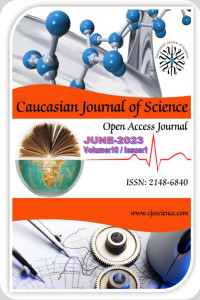Öz
Kaynakça
- Amirbozorgi, G., Samadlouie, H. & Shahidi, S.A. (2016). Identification and characterization of lactic acid bacteria isolated from Iranian traditional dairy products. International Biological and Biomedical Journal, 2(1), 47-52.
- Anonymous. (2009). Türk Gıda Kodeksi, Fermente Süt Ürünleri Tebliği (16 Şubat 2009-27143). Tebliğ No:2009/25.
- Anonymous. (2021). www. danonevitapole.com. Erisim tarihi: 19.03.2021.
- Arslan, S. (2015). A review: Chemical, microbiological and nutritional characteristics of kefir. Journal of Food, 13(3), 340-345.
- Bengoa, A.A., Iraporda, C., Garrote, G.L. & Abraham, A.G. (2018). Kefir micro-organism: Their role of grain assembly and health properties of fermented milk. Journal of Applied Microbiology, 126, 686-700.
- Clark, S., Costello, M., Drake, M. & Bodyfelt, F. (2008). The Sensory Evaluation of Dairy Products, Springer, CRC Press and Wood Head Publishing Limited, Cambridge, UK.
- Dahiya, D., & Nigam, P. S. (2023). Therapeutic and Dietary Support for Gastrointestinal Tract Using Kefir as a Nutraceutical Beverage: Dairy-Milk-Based or Plant-Sourced Kefir Probiotic Products for Vegan and Lactose-Intolerant Populations. Fermentation, 9(4), 388.
- Dave, R.I. & Sha, N.P. (1996). Evaluation of media for selective enumeration of Streptococcus thermophilus, Lactobacillus delbrueckii ssp. bulgaricus, Lactobacillus acidophilus and bifidobacteria. Journal of Dairy Science, 79(9), 1529-1536.
- Elmer, M. & James, S.L. (2001). Applied Dairy Microbiology, Marcel Dekker: Technology and Industrial Arts. Erdoğmuş, S.F. & Bostancı, B. (2020). Kefir örneklerinden laktik asit bakterilerinin izolasyonu, identifikasyonu ve antimikrobiyal etkilerinin değerlendirilmesi. The Journal of Food, 45(1), 72-80.
- Ergin, F., Öz, G., Özmen, Ü., Erdal, Ş., Çavana, E. & Küçükçetin, A. (2017). Sütün homojenizasyonunun kefirin fizikokimyasal ve mikrobiyolojik özellikleri üzerine etkisi. Akademik Gıda, 15(4), 368-376.
- FAO/WHO. (2001). Evaluation of health and nutritional properties of powder milk and live lactic acid bacteria, Food and Agriculture Organization of the United Nations and World Health Organization Expert Consultation Report, www.fao.org/documents/pub_dett.asp?lang=en &pub_id=61756 (Accessed 2 March 2019).
- Farnworth, E.R. (2005). Kefir-a complex probiotic. Food Science and Technology Bulletin, 2, 1-17.
- Fontan, M.C.G., Martinez, S., Franco, I. & Carballo, J. (2006). Microbiological ve chemical changes during the manufacture of kefir made from cow’s milk, using a commercial starter culture. International Dairy Journal, 16(7), 762-767.
- Garrote, G.L., Abraham, A.G. & De-Antoni, G.L. (2001). Chemical ve microbiological characterisation of kefir grains. Journal of Dairy Research, 68(4), 639-652.
- Gawel, J. & Gromadka, M. (1978). Chemical changes during fermentation and ripending of kefir. 20 th., Int. Dairy Cong. France. Published by Congrilait; Paris, 839-840.
- Gocer, E. M. C., & Koptagel, E. (2023). Production of milks and kefir beverages from nuts and certain physicochemical analysis. Food Chemistry, 402, 134252.
- Güven, A., Deveci, H. A., & Nur, G. (2021). The importance of kefir in healthy nutrition: Antioxidant and hypocholesterolemic effect. Healt Sciences. Theory, Current Researches and New Trends. Cetinje-Montenegro , 1-13.
- Güzel-Seydim, Z.B., Kök-Taş, T., Greene, K. & Seydim, A.C. (2011). Review: Functional properties of Kefir. Critical Reviews in Food Science and Nutrition, 51, 261-268.
- Güzel-Seydim, Z.B., Seydim, A.C. & Greene, A.K. (2000). Organic acids and volatile flavor components evolved during refrigerated storage of kefir. Journal of Dairy Science, 83, 275-277.
- Güzel-Seydim, Z., Wyffels, J.T., Seydim, A.C. & Greene, A.K. (2005). Turkish kefir and kefir grains: microbial enumeration and electron microscobic observation. International Journal of Dairy Technology, 58,1-29.
- Harmankaya, S., Gülbaz, G. & Kamber, U. (2019). The effect of essential oils of rosemary and clove on shelf life chicken meat. Van Veterinary Journal. 28(1), 11-19.
- IDF. (1983). Yogurt, Enumaration of Characteristic Microorganisims IDF Standart E 117. Belgium. İnal, T. (1990). Süt ve Süt Ürünleri Hijyen ve Teknolojisi. Final Ofset, İstanbul, 558- 566.
- Irigoyen, A., Arana, I., Castiella, M., Torre, P. & Ibanez, F.C. (2005). Microbiological, physicochemical, and sensory characteristics of kefir during storage. Food Chemistry, 90-620.
- Kadıoğlu, B.U. (2017). Probiyotik Süt ürünü olarak kefirin sağlıklı beslenmedeki yeri. Akademik Sosyal Araştırmalar Dergisi. 5(60), 135-145.
- Kakisu, E., Irigoyen, A., Torre, P., De Antoni, G.L. & Abraham, A.G. (2011). Physicochemical, microbiological and sensory profiles of fermented milk containing probiotic strains isolated from kefir. Journal of Dairy Research. 78, 456-463.
- Karagözlü, C. (1990). Farklı ısıl işlem uygulanmış inek sütlerinden kefir kültürü ve tanesi ile üretilen kefirlerin dayanıklılığı ve nitelikleri üzerine araştırmalar (Yüksek Lisans Tezi). Ege Üniversitesi Fen Bilimleri Enstitüsü Tarım Ürünleri Teknolojisi Anabilim Dalı.
- Karahan, Z.C. & Güvener, E. (1999). Probiyotikler. Flora İnfeksiyon Hastalıkları ve Klinik Mikrobiyoloji Dergisi, 4(3), 15162.
- Kesmen, Z. & Kaçmaz, N. (2011). Determination of Lactic Microflora of kefir grains and kefir beverage by using culture-dependent and culture-independent methods. Journal of Food Science, (76)-5.
- Kılıç, S., Güre, A. & Akbulut, N. (2001). Kefirin invivo koşulda bağırsak florası ve canlı ağırlık artışına etkisi. XII. Biyoteknoloji kongresi, September. 2001; 17-21 Ayvalık/ Balıkesir.
- Konar, A & Şahan, N. (1989). İnek, keçi ve koyun sütlerinden üretilen kefirlerin özellikleri ve bu özelliklere olgunlaştırma süresinin etkisi üzerine bir araştırma. Bursa I. Uluslararası Gıda Semp. 1989; 184-197.
- Kök-Taş, T., Ekinci, F.Y. & Guzel-Seydim, Z.B. (2012). Identification of microbial flora in kefir grains produced in Turkey using PCR. International Journal of Dairy Technology, 65, 1-131.
- Kurman, J.A., Rasic, J.L. & Kroger, M. (1992). Encyclopedia of fermented fresh milk products. Van Nostrand Reinhold. New York.
- López-Cuellar, R., Rodríguez-Hernández, A.I. & Chavarría-Hernández, N. (2016). LAB bacteriocin applications in the last decade. Biotechnology and Biotechnological Equipment, 30(6), 1039-1050.
- Metin, M. (2006). Analysis methods of milk and dairy products (sensory, physical and chemical analysis), Turkey, Ege University Publications, Number: 24, Izmir.
- Meyer, A.L., Elmadfa, I., Herbacek, I. & Micksche, M. (2007). Probiotic, as well as conventional yogurt, can enhance the stimulated production of proinflammatory cytokines. Journal of Human Nutrition and Dietetics, 20(6): 590-598.
- Otles, S. & Cagindi, O. (2003). Kefir: A probiotic dairy-composition, nutritional and therapeutic aspects. Pakistan Journal of Nutrition. 2(2), 54-59.
- Öner, Z., Karahan, A.G. & Çakmakçı, M.L. (2010). Effect of different milk types and starter cultures on kefir. The Journal of Food, 35: 3-182.
- Pripp, A. (2013). Statistics in Food Science and Nutrition. Springer, New York.
- Rosa, D.D., Dias, M.M.S., Grzeskowiak, L.M., Reis, S.A., Conceicao, L.L. & Peluzio, M. (2017). Milk kefir: Nutritional, microbiological and health benefits. Nutrition Research Reviews, 30(1), 82-96.
- Saloff-Coste, C.J. (1996). Kefir. Danone World Newsletter. 1996; No:11.
- Sezer, Ç. (2003). Kefirde laktik asit bakterilerinin tür düzeyinde araştırılması. (Yüksek Lisans Tezi), Kafkas Üniversitesi Sağlık Bilimleri Enstitüsü Besin Hijyeni ve Teknolojisi Anabilim Dalı.
- Tan, K. & Ertekin, Ö. (2017). Yerli ineklerden elde edilen sütlerden üretilen kefirin pH ve laktik asit bakteri değerleri. Bilim ve Gençlik Dergisi. 5(2), 155-159.
- Tekinşen, O.C. & Atasever, M. (1994). Süt ürünleri üretiminde starter kültür, Selçuk Üniv. Vet. Fak. Yayın Ünitesi, Konya.
- Toklu, Ş. (1999). Süt Şampanyası, Kefir. Gıda Derg. Dünya Yayıncılık, 99(6), 51-53.
- Vedamutlu, E.R. (1977). Exotic fermented dairy foods. Journal of Food Protection. 40, 801-802.
- Witthuhn, R.C., Schoeman, T. & Britz, T.J. (2005). Characterisation of the microbial population at different stages of Kefir production and Kefir grain mass cultivation. International Dairy Journal, 15, 383-389.
- Yaygın, H. (1995). Yoğurt, III. Süt ve Süt Ürünleri Sempozyumu 2-3 Haziran 1994- İstanbul, Milli Prodüktivite Merkezi Yayınları, No:548.
- Yüksekdağ, Z.N. & Beyatlı, Y. (2003). Kefir mikroflorası ile laktik asit bakterilerinin metabolik, antimikrobiyal ve genetik özellikleri. Orlab On-Line Mikrobiyoloji Dergisi, 1(2), 49-69.
- Zhang, Z., Vriesekoop, F., Yuan, Q. & Liang, H. (2014). Effects of nisin on the antimicrobial activity of d-limonene and its nanoemulsion. Food Chemistry, 150, 307-312.
Öz
The aim of this study was to examine the effect of different incubation times on the shelf life of kefir. For this purpose, kefir samples were first incubated for 8, 12, 18, 24 and 36 hours, creating 5 different kefir groups. It was then stored at 4±1°C for 21 days.. Microbiological (Lactobacillus spp., Lactococcus spp., and yeast), chemical (pH, titratable acidity), and sensory analyses of the kefir groups were performed during the storage period. The Lactobacillus (7.80 log10 cfu/mL), Lactococcus (7.30 log10 cfu/mL) and yeast (6.14 log10 cfu/mL) counts were higher in the kefir groups that were incubated for a long time, and changes were observed during the storage process depending on the incubation time. It was determined that the titratable acidity became higher as the length of the incubation and storage time increased. The results showed that the incubation time had an effect on Lactobacillus spp. and Lactococcus spp. counts, pH and acidity (P<0.05).
Anahtar Kelimeler
Kefir Incubation time Lactobacillus spp. Lactococcus spp. Yeast
Kaynakça
- Amirbozorgi, G., Samadlouie, H. & Shahidi, S.A. (2016). Identification and characterization of lactic acid bacteria isolated from Iranian traditional dairy products. International Biological and Biomedical Journal, 2(1), 47-52.
- Anonymous. (2009). Türk Gıda Kodeksi, Fermente Süt Ürünleri Tebliği (16 Şubat 2009-27143). Tebliğ No:2009/25.
- Anonymous. (2021). www. danonevitapole.com. Erisim tarihi: 19.03.2021.
- Arslan, S. (2015). A review: Chemical, microbiological and nutritional characteristics of kefir. Journal of Food, 13(3), 340-345.
- Bengoa, A.A., Iraporda, C., Garrote, G.L. & Abraham, A.G. (2018). Kefir micro-organism: Their role of grain assembly and health properties of fermented milk. Journal of Applied Microbiology, 126, 686-700.
- Clark, S., Costello, M., Drake, M. & Bodyfelt, F. (2008). The Sensory Evaluation of Dairy Products, Springer, CRC Press and Wood Head Publishing Limited, Cambridge, UK.
- Dahiya, D., & Nigam, P. S. (2023). Therapeutic and Dietary Support for Gastrointestinal Tract Using Kefir as a Nutraceutical Beverage: Dairy-Milk-Based or Plant-Sourced Kefir Probiotic Products for Vegan and Lactose-Intolerant Populations. Fermentation, 9(4), 388.
- Dave, R.I. & Sha, N.P. (1996). Evaluation of media for selective enumeration of Streptococcus thermophilus, Lactobacillus delbrueckii ssp. bulgaricus, Lactobacillus acidophilus and bifidobacteria. Journal of Dairy Science, 79(9), 1529-1536.
- Elmer, M. & James, S.L. (2001). Applied Dairy Microbiology, Marcel Dekker: Technology and Industrial Arts. Erdoğmuş, S.F. & Bostancı, B. (2020). Kefir örneklerinden laktik asit bakterilerinin izolasyonu, identifikasyonu ve antimikrobiyal etkilerinin değerlendirilmesi. The Journal of Food, 45(1), 72-80.
- Ergin, F., Öz, G., Özmen, Ü., Erdal, Ş., Çavana, E. & Küçükçetin, A. (2017). Sütün homojenizasyonunun kefirin fizikokimyasal ve mikrobiyolojik özellikleri üzerine etkisi. Akademik Gıda, 15(4), 368-376.
- FAO/WHO. (2001). Evaluation of health and nutritional properties of powder milk and live lactic acid bacteria, Food and Agriculture Organization of the United Nations and World Health Organization Expert Consultation Report, www.fao.org/documents/pub_dett.asp?lang=en &pub_id=61756 (Accessed 2 March 2019).
- Farnworth, E.R. (2005). Kefir-a complex probiotic. Food Science and Technology Bulletin, 2, 1-17.
- Fontan, M.C.G., Martinez, S., Franco, I. & Carballo, J. (2006). Microbiological ve chemical changes during the manufacture of kefir made from cow’s milk, using a commercial starter culture. International Dairy Journal, 16(7), 762-767.
- Garrote, G.L., Abraham, A.G. & De-Antoni, G.L. (2001). Chemical ve microbiological characterisation of kefir grains. Journal of Dairy Research, 68(4), 639-652.
- Gawel, J. & Gromadka, M. (1978). Chemical changes during fermentation and ripending of kefir. 20 th., Int. Dairy Cong. France. Published by Congrilait; Paris, 839-840.
- Gocer, E. M. C., & Koptagel, E. (2023). Production of milks and kefir beverages from nuts and certain physicochemical analysis. Food Chemistry, 402, 134252.
- Güven, A., Deveci, H. A., & Nur, G. (2021). The importance of kefir in healthy nutrition: Antioxidant and hypocholesterolemic effect. Healt Sciences. Theory, Current Researches and New Trends. Cetinje-Montenegro , 1-13.
- Güzel-Seydim, Z.B., Kök-Taş, T., Greene, K. & Seydim, A.C. (2011). Review: Functional properties of Kefir. Critical Reviews in Food Science and Nutrition, 51, 261-268.
- Güzel-Seydim, Z.B., Seydim, A.C. & Greene, A.K. (2000). Organic acids and volatile flavor components evolved during refrigerated storage of kefir. Journal of Dairy Science, 83, 275-277.
- Güzel-Seydim, Z., Wyffels, J.T., Seydim, A.C. & Greene, A.K. (2005). Turkish kefir and kefir grains: microbial enumeration and electron microscobic observation. International Journal of Dairy Technology, 58,1-29.
- Harmankaya, S., Gülbaz, G. & Kamber, U. (2019). The effect of essential oils of rosemary and clove on shelf life chicken meat. Van Veterinary Journal. 28(1), 11-19.
- IDF. (1983). Yogurt, Enumaration of Characteristic Microorganisims IDF Standart E 117. Belgium. İnal, T. (1990). Süt ve Süt Ürünleri Hijyen ve Teknolojisi. Final Ofset, İstanbul, 558- 566.
- Irigoyen, A., Arana, I., Castiella, M., Torre, P. & Ibanez, F.C. (2005). Microbiological, physicochemical, and sensory characteristics of kefir during storage. Food Chemistry, 90-620.
- Kadıoğlu, B.U. (2017). Probiyotik Süt ürünü olarak kefirin sağlıklı beslenmedeki yeri. Akademik Sosyal Araştırmalar Dergisi. 5(60), 135-145.
- Kakisu, E., Irigoyen, A., Torre, P., De Antoni, G.L. & Abraham, A.G. (2011). Physicochemical, microbiological and sensory profiles of fermented milk containing probiotic strains isolated from kefir. Journal of Dairy Research. 78, 456-463.
- Karagözlü, C. (1990). Farklı ısıl işlem uygulanmış inek sütlerinden kefir kültürü ve tanesi ile üretilen kefirlerin dayanıklılığı ve nitelikleri üzerine araştırmalar (Yüksek Lisans Tezi). Ege Üniversitesi Fen Bilimleri Enstitüsü Tarım Ürünleri Teknolojisi Anabilim Dalı.
- Karahan, Z.C. & Güvener, E. (1999). Probiyotikler. Flora İnfeksiyon Hastalıkları ve Klinik Mikrobiyoloji Dergisi, 4(3), 15162.
- Kesmen, Z. & Kaçmaz, N. (2011). Determination of Lactic Microflora of kefir grains and kefir beverage by using culture-dependent and culture-independent methods. Journal of Food Science, (76)-5.
- Kılıç, S., Güre, A. & Akbulut, N. (2001). Kefirin invivo koşulda bağırsak florası ve canlı ağırlık artışına etkisi. XII. Biyoteknoloji kongresi, September. 2001; 17-21 Ayvalık/ Balıkesir.
- Konar, A & Şahan, N. (1989). İnek, keçi ve koyun sütlerinden üretilen kefirlerin özellikleri ve bu özelliklere olgunlaştırma süresinin etkisi üzerine bir araştırma. Bursa I. Uluslararası Gıda Semp. 1989; 184-197.
- Kök-Taş, T., Ekinci, F.Y. & Guzel-Seydim, Z.B. (2012). Identification of microbial flora in kefir grains produced in Turkey using PCR. International Journal of Dairy Technology, 65, 1-131.
- Kurman, J.A., Rasic, J.L. & Kroger, M. (1992). Encyclopedia of fermented fresh milk products. Van Nostrand Reinhold. New York.
- López-Cuellar, R., Rodríguez-Hernández, A.I. & Chavarría-Hernández, N. (2016). LAB bacteriocin applications in the last decade. Biotechnology and Biotechnological Equipment, 30(6), 1039-1050.
- Metin, M. (2006). Analysis methods of milk and dairy products (sensory, physical and chemical analysis), Turkey, Ege University Publications, Number: 24, Izmir.
- Meyer, A.L., Elmadfa, I., Herbacek, I. & Micksche, M. (2007). Probiotic, as well as conventional yogurt, can enhance the stimulated production of proinflammatory cytokines. Journal of Human Nutrition and Dietetics, 20(6): 590-598.
- Otles, S. & Cagindi, O. (2003). Kefir: A probiotic dairy-composition, nutritional and therapeutic aspects. Pakistan Journal of Nutrition. 2(2), 54-59.
- Öner, Z., Karahan, A.G. & Çakmakçı, M.L. (2010). Effect of different milk types and starter cultures on kefir. The Journal of Food, 35: 3-182.
- Pripp, A. (2013). Statistics in Food Science and Nutrition. Springer, New York.
- Rosa, D.D., Dias, M.M.S., Grzeskowiak, L.M., Reis, S.A., Conceicao, L.L. & Peluzio, M. (2017). Milk kefir: Nutritional, microbiological and health benefits. Nutrition Research Reviews, 30(1), 82-96.
- Saloff-Coste, C.J. (1996). Kefir. Danone World Newsletter. 1996; No:11.
- Sezer, Ç. (2003). Kefirde laktik asit bakterilerinin tür düzeyinde araştırılması. (Yüksek Lisans Tezi), Kafkas Üniversitesi Sağlık Bilimleri Enstitüsü Besin Hijyeni ve Teknolojisi Anabilim Dalı.
- Tan, K. & Ertekin, Ö. (2017). Yerli ineklerden elde edilen sütlerden üretilen kefirin pH ve laktik asit bakteri değerleri. Bilim ve Gençlik Dergisi. 5(2), 155-159.
- Tekinşen, O.C. & Atasever, M. (1994). Süt ürünleri üretiminde starter kültür, Selçuk Üniv. Vet. Fak. Yayın Ünitesi, Konya.
- Toklu, Ş. (1999). Süt Şampanyası, Kefir. Gıda Derg. Dünya Yayıncılık, 99(6), 51-53.
- Vedamutlu, E.R. (1977). Exotic fermented dairy foods. Journal of Food Protection. 40, 801-802.
- Witthuhn, R.C., Schoeman, T. & Britz, T.J. (2005). Characterisation of the microbial population at different stages of Kefir production and Kefir grain mass cultivation. International Dairy Journal, 15, 383-389.
- Yaygın, H. (1995). Yoğurt, III. Süt ve Süt Ürünleri Sempozyumu 2-3 Haziran 1994- İstanbul, Milli Prodüktivite Merkezi Yayınları, No:548.
- Yüksekdağ, Z.N. & Beyatlı, Y. (2003). Kefir mikroflorası ile laktik asit bakterilerinin metabolik, antimikrobiyal ve genetik özellikleri. Orlab On-Line Mikrobiyoloji Dergisi, 1(2), 49-69.
- Zhang, Z., Vriesekoop, F., Yuan, Q. & Liang, H. (2014). Effects of nisin on the antimicrobial activity of d-limonene and its nanoemulsion. Food Chemistry, 150, 307-312.
Ayrıntılar
| Birincil Dil | İngilizce |
|---|---|
| Konular | Biyokimya ve Hücre Biyolojisi (Diğer) |
| Bölüm | Caucasian Journal of Science |
| Yazarlar | |
| Yayımlanma Tarihi | 10 Temmuz 2023 |
| Gönderilme Tarihi | 7 Temmuz 2023 |
| Kabul Tarihi | 10 Temmuz 2023 |
| Yayımlandığı Sayı | Yıl 2023 Cilt: 10 Sayı: 1 |
Cited By
Selection of appropriate probiotic yeasts for use in dairy products: a narrative review
Food Production, Processing and Nutrition
https://doi.org/10.1186/s43014-024-00293-x








